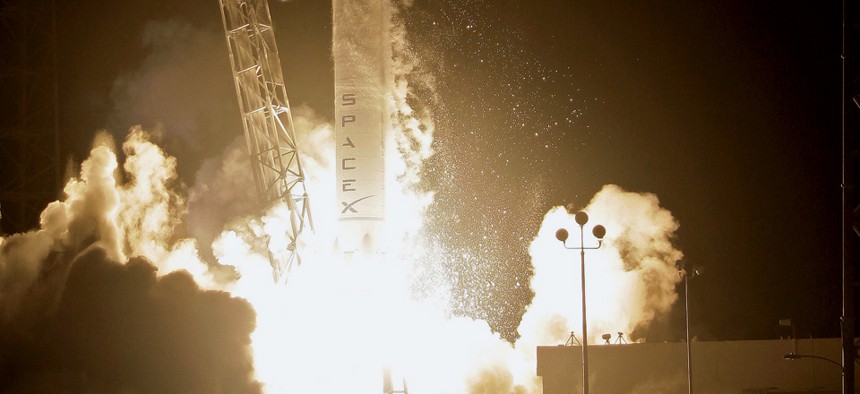
Terry Renna/AP
Twenty-five years ago, Defense Department officials were deeply worried about the health of dozens of companies they depended on to supply military troops with critical weapons and equipment. As the Cold War melted down, the department’s senior leaders knew they wouldn’t have enough work to sustain some 50 defense contractors, so they explicitly encouraged companies to restructure and consolidate. Corporate executives aggressively embraced the advice—today, there are just six major defense companies. Pentagon officials have spent much of the last several years trying to undo the damage.
As fewer firms have strengthened their grip on fewer weapons contracts, competition has dwindled and costs have skyrocketed, threatening many programs with what service officials call the “acquisition death spiral,” when costs spin so far out of control that programs have to be killed. The Pentagon has walked away from at least a dozen such programs since 2001 after sinking nearly $50 billion into weapons that will never see a battlefield.
Last spring, Space Exploration Technologies Corp., known as SpaceX, shook up the defense contracting world with a lawsuit against the Air Force charging unfair contracting practices when, without competition, the service tapped United Launch Alliance for dozens of future satellites launches. The Air Force maintained that only ULA—a joint venture of defense stalwarts Lockheed Martin and Boeing—was certified to perform the work. SpaceX, which has flown missions to the International Space Station on behalf of NASA, essentially said the Air Force contract shut out competition. While a federal judge considers the case, the Air Force and SpaceX have been cooperating to certify the company’s Falcon 9 rocket for carrying military payloads into space; officials say SpaceX could be fully certified to compete for future military launches by the end of the year.
“This is not SpaceX protesting and saying these launches should be awarded to us,” Elon Musk, the entrepreneur behind the company told reporters at the National Press Club in April. “We’re just saying these launches should be competed. If we compete and lose, that’s fine. But why would they not even compete it?”
Frank Kendall, the Pentagon’s top weapons buyer, agrees that competition is good. “It works better than anything else to reduce and control costs.” Unfortunately, the Pentagon’s own data shows the department is losing ground in the percentage of contracted work being let competitively each year. In 2008, 64 percent of Defense contract dollars were spent through competitive awards; by 2013, that rate had fallen to 57 percent.
Kendall blames the erosion, in part, on the Pentagon’s decreasing budget and on spending caps imposed by the 2011 Budget Control Act, factors that came into play with the contested award to United Launch Alliance, Defense officials say. “We were moving aggressively toward introducing competition [for the Air Force launch program] when budget cuts forced the deferral of about half the launches scheduled for competition,” Kendall told Senate lawmakers in April.
Thanks to its flamboyant and outspoken founder, SpaceX may be the best known non-defense company trying to break into an exclusive club, but it’s not the only company frustrated by Pentagon contracting practices. Italy’s Finmeccanica SpA sued the government in September to block an $800 million Army contract with Airbus Group for a new helicopter to replace two older models the service plans to retire. The Army is now reviewing those plans.
The problems companies like SpaceX and Finmeccanica face in doing business with the Pentagon have long been predicted. Six years ago, the Defense Science Board warned of a “coming crisis” precipitated by defense industrial consolidation. The board noted that the cost of weapons systems has risen dramatically and despite significant increases in defense spending between 2001 and 2006, the Pentagon had to rely on supplemental funds appropriated by Congress to pay for wars in Afghanistan and Iraq.
“In this environment, the net sales of large defense firms skyrocketed and profits reached record heights,” the board said, yet little of that revenue was invested in capital equipment or research and development. “There is growing concern over whether adequate competition is possible within the newly consolidated defense industrial structure.”
Todd Harrison, a senior fellow at the Center for Strategic and Budgetary Assessments, says a serious challenge is that U.S. defense industry doesn’t operate like a free market. “It can be more accurately characterized as a monopsony with the U.S. government as the sole customer and chief regulator. There are few (if any) other buyers for many of the major weapon systems DOD procures, such as stealthy aircraft, aircraft carriers, nuclear-powered submarines, and specialized communications and electronics equipment,” Harrison wrote in an essay for a Senate Homeland Security and Governmental Affairs Committee report on acquisition reform.
As the sole customer for many of the systems it buys, the Pentagon pays the full development cost. To create competition, DOD typically pays two or more contractors to develop similar systems, Harrison says. “Even if DOD pays for the development work only once and gives the same design to two or more companies for production (a “build to print” approach), it must still pay for the establishment of multiple production lines. Once development work is complete, DOD can down-select to a single vendor for production using a competitive process. This effectively ends the competition and grants the winner a monopoly for future procurements of the same system.”
Michael J. Sullivan, director of acquisition and sourcing management at the Government Accountability Office, says the absence of a true free market means “there is less competition, more regulation, and once a contract is awarded, the contractor has considerable power.” And the closer things get to production, the more the Pentagon has to lose.







